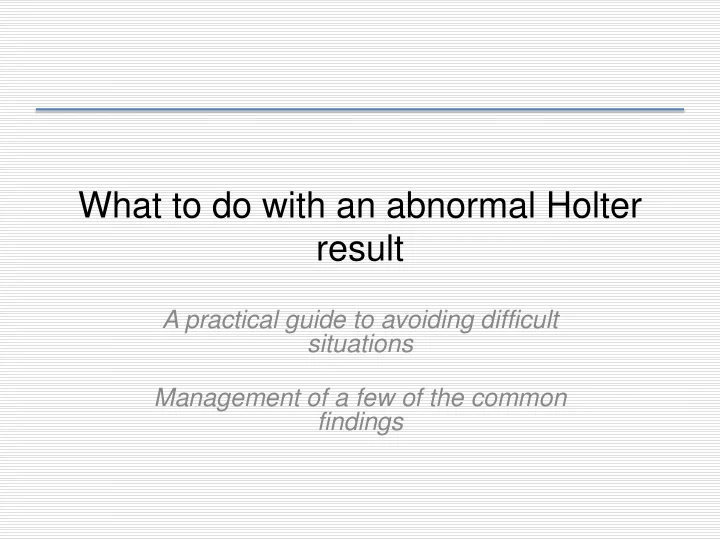

What to do with an abnormal Holter result A practical guide to avoiding difficult situations Management of a few of the common findings
Conflicts • None
What to do with an Abnormal Holter Pt. 1 Dx: Sinus node dysfunction, 1 o AVB, RBBB
What to do with an Abnormal Holter • Usually we are evaluating for: – Symptoms • Palpitations • Dizziness – Events • Syncope • Sudden cardiac arrest • Occasionally for asymptomatic reasons – Heart rate control during persistent AF – Evaluate for occult AF
Retrospective Analysis of Ambulatory ECG • 7,364 24 hour monitors – 21% were ordered for syncope evaluation – Yield: • Syncope/near syncope w arrhythmia: 2% • Syncope/near syncope w/o arrhythmia: 15% – Poor sensitivity • Can be improved by longer monitoring – Poor specificity • Can be improved by using patient activated method Gibson TC. Am J Cardiol. 1984;53:1013-1017
Pt. 1 Symptom Diary
Arrhythmia frequency, monitor duration, and likelihood of detection • If the patient is in PAF 26% to 50% of the time, likely to detect with 48hr monitor • If in PAF only 1% of the time, unlikely to detect with 48hr monitor; 95% detected in 5 days • Most arrhythmias are much less frequent than this hence need longer monitoring • Only about half of the episodes of AF are associated with symptoms Turakhia MP, Am J Cardiol 2013;112:520-524
Improving sensitivity and specificity
iRhythm Patch Like a Holter, it records every beat, and has a symptom trigger button Stays on the skin and records up to 14 days (median = 10); patient can shower Much less intrusive than most recording devices; is peeled off and mailed back
Smartphone devices for inexpensive long- term monitoring Alivecor: www.alivecor.com $200 Prescription Cardiac Designs: www.cardiacdesigns.com $100 OTC
Implantable Loop Recorders PICTURE registry: Recurrent unexplained syncope or presyncope 570 patients had undergone evaluation by an average of three different specialists 9 – 20 nondiagnostic tests (median 13) Syncope occurred in 30% of patients the first year; in 78% of those a dx was made Edvardsson N. Europace . Feb 2011;13(2):262-269
Patient Activated Pacemaker Recordings Atrium Ventricle
Patient 1
Some Class 1 Pacing Indications Principal: Reduction of Symptoms and Events • Symptomatic bradycardia or chronotropic incompetence – Except due to unnecessary medical therapy • Asymptomatic third degree and advanced second degree heart block (while awake) with pauses > 3 seconds or escape rate < 40, or during AF, > 5 sec • Advanced second degree HB, intermittent third degree HB, or alternating bundle branch block in the setting of chronic bifascicular block • Patient 1 had RBBB and sinus pauses of 2.8 sec but did not have evidence of advanced heart block or other criteria
Pt. 2. Palpitations and dizziness: 3 events during 48 hours Normal AV conduction, asymptomatic sinus pauses 4.28 sec
Pt. 3: Paroxysmal AF, symptomatic
Management of PAF Principal: Reduction of Symptoms and Events • Asymptomatic – Proper anticoagulation • Symptomatic – Proper anticoagulation, plus • Nothing, if sx infrequent, brief, mild • “Pill in the Pocket” if infrequent, prolonged episode • Continuous medical therapy if frequent episodes • Ablation or surgery if medical options ineffective
Atrial Flutter – “Typical” 1. Consistent flutter waves – morphology and cycle length 2. Inverted in the inferior leads 3. Upright in V1
Pt. 4: NSVT, Asymptomatic
Management of NSVT • Asymptomatic – Normal LV function: • Usually conservative management, i.e. nothing • Symptomatic – Normal LV function • Beta blockers, Ca++ blockers, ablation – Depressed LV function • Standard medical treatment of LV dysfunction x months • Repeat measurement of LV function • May be candidate for prophylactic ICD if not improved
RVOT Anatomy
RF delivered to that site during VT VT terminates about 1 sec later I aVF V1
The role of these devices Duration Method Pro Con Utility Short Automated BP cuff Inexpensive Low quality Lots data EKG in clinic or EMTs Inexpensive; Lots high quality Holter High quality Not very long Lots iRhythm Patch Pt + Auto; up Lots to 2 weeks HeartCard Easy Lots Event Monitor Pt activated or Lots auto-activated Mobile Continuous Outpatient Too much I never use it Telemetry data and cost Smartphone accessory Inexpensive Great for infrequent sx in the savvy patient Implantable Loop Recorder Lasts 3 years. Expensive Best for infrequent sx in the Auto-activated infirm patient Long Pacemaker reprogram Very high Always use if pacemaker is quality data present
Summary • Give thought to the various monitoring methods beforehand and you will improve sensitivity and eliminate many false alarms – Patient activated modalities are especially helpful • Consider some of the low tech methods – Automated BP cuff, Fire station, clinic EKG • Consider some of the high tech methods – iRhythm patch, AliveCor or Cardiac Designs monitors, reprogramming of pacemaker (if present) to enable patient activated recording function • If recordings are in a grey area, don’t hesitate to call
Atrial Flutter / Atrial Tach
An Approach to the Abnormal Holter: Based on symptoms, events, and their relationship Did symptoms occur during monitoring period? Yes. No. Are abnormalities Are abnormalities recorded? recorded? No. Yes. No. Yes. Non-arrhythmic cause Are these events and for symptoms symptoms correlated? No dx made; will need No. Yes. another modality; No dx made; will need Asymptomatic incidental another modality Diagnosis made Asymptomatic incidental finding finding • Asymptomatic incidental findings are a major problem and can be avoided by using patient activated modalities • Recordings without a symptomatic episode can usually be avoided by choosing a more prolonged modality
Finding Earliest Ventricular Activation ECG Leads Ablation Catheter
EKG of patient with 2.8 sec pauses She has RBBB but not bifascicular block, asymptomatic pauses < 3 sec
Recommend
More recommend